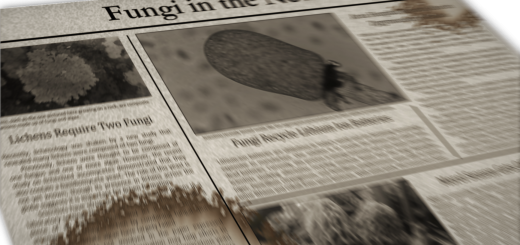#067: Holy Flying Fungus, Batman!
Note: This is an archived post.
What if you could grow biodegradable packing materials… or a surfboard… or maybe even a drone? It turns out you can, thanks to the unique properties of fungi. One thing that fungi are especially good at doing is knitting things together. This can be seen particularly well on the forest floor. By the end of summer, most of the leaf litter has been stitched together by microscopic fungal cells. If you reach down and pick up a leaf, you will likely find that a few others come up with it. The same is true with garden mulch. If you pulled up any dead annual plants recently, you probably noticed that your mulch was glued together in chunks by white stuff. This white glue is actually a network of fungal cells (called a mycelium). At this point, I should probably mention that you want the fungus in your mulch. The fungus is decomposing your mulch, which releases nutrients and helps your plants grow. In much the same way that plant roots stabilize a stream bank, the fungal mycelium ties together various parts of the substrate in which it is growing.
Seven years ago, a couple of engineers figured out a way to take advantage of this unique fungal property in order to produce foam blocks. Their resulting company, Ecovative, is still growing today. Although the recipe to create these fungal foam blocks is fairly simple, the applications have the potential to change the world. Production of fungal foam begins with agricultural byproducts like plant stalks or seed husks. These plant materials are then sterilized to get rid of any competing microorganisms. Next, water and little bits of mycelium (the exact species of fungus is a secret) are added to this fungus food and the mixture is poured into a plastic mold. The mold is left to sit for five days, during which time the fungus grows throughout the available space and ties all the little pieces together. The resulting block of living material is then removed from the mold, heated, and dried. This kills the fungus, which prevents the materials from decomposing any further and prevents the fungus from producing mushrooms and spores. Heat treating the blocks also makes them stiff, water-resistant, and fire-resistant.
Fungal foam has a wide range of applications. It can be used as: packing material, insulation in houses and cars, and structural components of chairs and surfboards. In all of these uses, it replaces petroleum-based products, which take an incredibly long time to degrade and often release harmful chemicals in the process. Petroleum-based products frequently also require chemical additives to achieve desired properties (like fire-resistance, for example). These chemicals only increase the amount of ecological harm caused by traditional foams. Fungal foam, on the other hand, can achieve the same functionality without chemical additives and naturally breaks down in the environment. When kept dry, the bio-foam can last a very long time. However, it easily composts within a month and will disappear completely from other environments in less than a year. Ecovative sells most of its fungal foam as packing materials. Fungal packing materials are only slightly more expensive than Styrofoam, and the price is likely to drop as the technology matures and the company expands. Styrofoam still beats fungi in the weight category, however. This is probably the fungal foam’s main obstacle to becoming commonplace. But from an environmental perspective, the benefits far outweigh this added cost. Companies experimenting with this unusual packing material include Dell, Crate and Barrel, Ford, and Sealed Air (the Bubble Wrap people).
Recently, a NASA mentor and a group of college students in the International Genetically Engineered Machine (iGEM) contest found a new use for fungal foam: as the structural component of drones. Drones can be useful tools for biological researchers, but they have their limitations. Crashes are not unheard of and sometimes drones cannot be retrieved from biologically sensitive areas. A solution to this problem would be to create a biodegradable drone. In a first step toward making this a reality, the team designed a drone with a completely biodegradable body. Blocks of fungal foam from Ecovative provided the main structure for the drone. To make that frame more durable, the team encased it in bacterial cellulose and proteins found in paper wasp spit. These make the frame hard and waterproof, respectively. The drone’s circuits were printed using silver nanoparticle ink, which should allow them to degrade faster than traditional circuits. Unfortunately, the remaining parts could not yet be replaced with eco-friendly analogues. The batteries, electric motors, and sensors still rely on old-fashioned electronics.
Although biodegradable drones and fungal foam are not likely to be common in the near future, this new technology has the potential to help change our world. This is just another way that fungi are helping to make the world a better place.
See Further:
http://www.cnn.com/2014/12/10/tech/innovation/nasa-dissolving-drone/
http://www.pbs.org/wgbh/nova/tech/mushroom-material.html
http://www.huffingtonpost.ca/2012/03/08/from-fungi-to-foam-new-y_n_1331431.html
http://www.newyorker.com/magazine/2013/05/20/form-and-fungus
http://www.unep.org/greeneconomy/Portals/88/documents/Case54_Fungi_en.pdf







![#011: Characteristics of Kingdom Fungi [Archived]](https://www.fungusfactfriday.com/wp-content/themes/hueman/assets/front/img/thumb-small-empty.png)
